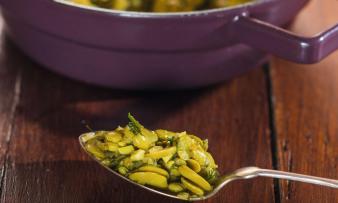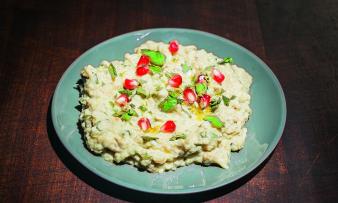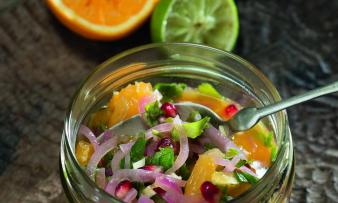Vegan Middle East
Parvin Razavi, Grub StreetISBN 978-1-910690-37-6, Pages 191, Size 245mm x 175mm
Raw recipes 5, Cooked recipes 76
The vegan recipe book "Vegan Middle East" offers recipes from the Middle East. Culinary delights from different culinary cultures for more enjoyment.
With Vegan Middle East, Parvin Razavi created a cooking book that contains easily prepared recipes, which most often can be made in a short time. While vegetables of all kind are the main ingredients, the variety of herbs and spices make the dishes so excitingly different from those vegan recipes we’re seeing so often.
About the author
Born in Iran and emigrated to Austria, Parvin Razavi was influenced by her middle eastern family and fascinated by scents. She started experimenting with food at an early age. Today she is writing her food blog "thx4cooking", works as an editor for Biorama, a magazine for a sustainable lifestyle and offers her cooking in form of private catering commissions.
Contents
This book starts with a foreword about the author. The glossary introduces typical middle eastern ingredients illustrated by colorful drawings.
The recipes are divided into six chapters by the country of origin:
- Iran
- Armenia
- Syria, Lebanon, Jordan
- Egypt
- Morocco
- Turkey
Each chapter starts with a register of the dishes shown in this section.
In the middle east it is common, to serve several dishes at once, instead of serving one dish per meal only, called mezze. In Vegan Middle East the author adheres to this tradition with classical courses composed out of main courses, side dishes, hot drinks and desserts. In between she intersperses chosen ingredients such as artichokes and dates.
Recipes
Iran
Light dishes with yogurt or citrus salad and pickled vegetable are among the recipes as well as soups and stews using lentils or beans and rice dishes combined with flavorful spices and herbs. You’ll find here for example "Broad bean stew with dill sauce" (Ackerbohneneintopf mit Dillsauce) and "Blanched spinach with soya yogurt".
Armenia
"Chickpeas with spinach", "Mante (homemade dumplings) stuffed with squash” and “stuffed vine leaves” are recipes among the Armenian dishes.
Syria, Lebanon, Jordan
This chapter includes mainly mezzes such as “Hummus, with curry”, “Aubergine mousse with tahini” (Auberginen-Mousse mit Tahini) and “Lebanese bread”.
Egypt
Apart from one, all recipes offered here are main courses. Lentils, beans, couscous, chickpeas and potatoes are the main ingredients found here. “Egyptian falafel”, “Stuffed tomatoes” and “white bean stew” are among those dishes.
Morocco
This chapter contains dishes with lots of vegetables, like “Caramelized fennel with fennel seeds and barberries” and “Vegetable tagine with quince”, a stew containing courgette, using cumin and cinnamon as spices.
Turkey
“Börek stuffed with swiss chard”, “Braised artichokes” and “Turkish semolina cake” are among the Turkish dishes.
Summary / overall impression
In Vegan Recipes from the Middle East Parvin Razani provides the reader with a broad selection of flavorful dishes from different cultures which are mostly easy to prepare. The recipes are middle eastern classics but you’ll also find some tasty surprises. The author focuses on the use of fresh ecological and organic ingredients. In terms of soya only soya yogurt is used which, if wished, can be replaced easily by any other vegetable-based yogurt. Spices and herbs such as cumin, saffron, turmeric, cinnamon, cardamom, dill and coriander are often used ingredients. Among the dishes desserts, which in the middle east often contain bigger amounts of sugar and oil, are reduced to a few only. The presentation of the book is clear, containing preparation- and cooking time, tips and beautiful pictures for all of the listed recipes. Background information about selected ingredients allows the reader to get a better understanding of the Middle Eastern culture.
An appealing cooking book for vegan and non-vegan people and for all who are curious experiencing something new.
Vegan recipes from the middle east gives vegan cooking a different direction and enables the reader to experience some new flavorful culinary delights.
The cooking book Vegan Recipes from the Middle East is published by Grub Street.
Book review by Dr. med. vet. Inke Weissenborn
This broad bean stew gets its typical oriental flavor from the combination of fresh dill, garlic, turmeric, and lemon juice.
Aubergine Mousse with Tahini, Parsley, and Pomegranate goes well with Lebanese bread and meze, which are appetizers often served with an apperitif.
Orange and Coriander Relish with Lime and Pomegranate Seeds is a healthy Moroccan side dish that will add a fresh, fruity flavor to your meal.





Comments